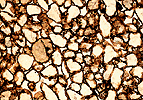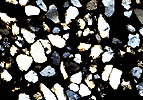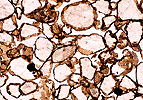


Podzolization encompasses the downward migration of Al and Fe, together with organic matter, from the surface areas and their accumulation in the profile's deep areas.
This process is characterised by a strong acidity that causes the slow development of organic matter (which releases abundant organic compounds with an acidic nature) and an extreme alteration of the mineral phase (releasing abundant elements that are lixiviated by the drainage waters, while the medium is enriched with insoluble elements, such as Fe and Al, which are migrated downward by the organic compounds towards deeper horizons). In short, an eluvial horizon is formed on the surface with intense substance losses.
The organometallic complexes migrate to the subsurface horizons and they accumulate originating the Bh and Bs horizon of the podzols, in short leaving a very differentiated profile with a very complete and very noticeable horizon consequence: O/A/E/Bh/Bs.
The evidence that the podzolization process
has developed in a soil is reflected in the profile's spectacular
micromorphology, with abundant coverings of organic matter on
the sand grains in horizon Bh.


